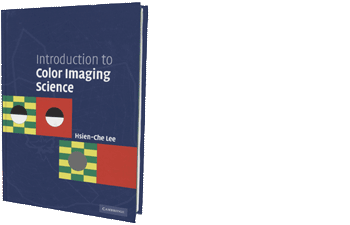Book Reviews
Book Reviews
Introduction to Color Imaging Science
Hsien-Che Lee
Cambridge University Press, 2005; $120.00 (hardcover)

Color Imaging Science provides a comprehensive introduction to the physics of color and light, how the eye and instruments capture color images, the measurement and calibration of color and how color images are displayed and processed.
Color is an important part of our world; we perceive it, use it and measure it. We all know color, but what exactly is it? Color is linked to spectroscopy, with applications to atomic physics, astronomy and atomic spectra. While the frequency of radiation is a physical quantity, color is perceived by the human visual system and is influenced by the source of illumination, brightness and many other factors. Newton decomposed white light from the sun into spectral colors with his dispersive prisms and formed white light from spectral colors. The list of researchers who have worked on the physics of color and color perception is impressive: Thomas Young, Rene Decartes, Johann Goethe, Johannes Purkinje, Hermann von Helmholtz, Fritz Kohlrausch, James Clerk Maxwell, Wilhelm Ostwald, A.H. Munsell and Erwin Schrödinger.
This book embraces optics, radiometry, photometry, colorimetry, color science, color vision, visual perception, dyes, pigments, photography, image sensors, image displays, image quality and graphic arts. There is uniformly high quality and a similar organization across the 22 chapters.
The book is replete with figures showing experimental data, and it strikes a good balance between text and equations. There are numerous tables and figures, and each chapter contains sets of homework problems. The appendixes contain data tables for quantitative calculations. In addition, there is a glossary, more than 1,000 key references and an index.
The book is targeted to engineers and scientists in the color image industry, but could also be used as a text for graduate courses on advanced color imaging.
The author researched many of these topics, taught courses in related fields, and published and obtained patents related to color imaging. He succeeded in his goal to write authoritatively on disparate topics and present the information in a clear and concise manner. What differentiates this book from others is that the author has studied the primary literature; other authors too often rely on secondary sources.
The book is unique in its dual presentation of models and theories. Physics and mathematics are made clear, and the author states the assumptions of the models and their applicability and limitations. I know of no other book that compares with Color Imaging Science, and I strongly recommend it.
[ Review by Barry R. Masters, OSA Fellow, SPIE Fellow, MIT, Cambridge, Mass. ]
Log in or become a member to view the full text of this article.
This article may be available for purchase via the search at Optica Publishing Group.
Optica Members get the full text of Optics & Photonics News, plus a variety of other member benefits.
